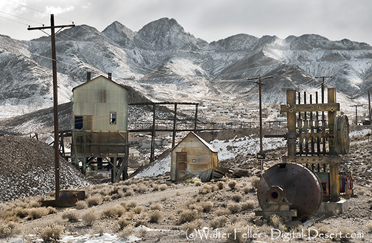The Land and Early Inhabitants

Beatty, Nv. 1905
The discovery of an incomparable deposit of silver on the eastern flank of Mount Davidson in the Washoe Mountains of western Nevada in 1859 resulted in the migration of 60,000 people into the Nevada Territory; this sudden influx provided the basis for statehood in 1864. There were numerous smaller discoveries in the surrounding area in the ensuing twenty years. By 1880, the majority of these discoveries had followed a boom-and bust pattern, and most of the mining camps they had spawned vanished. The state of Nevada fell on hard times. Its population shrank to 40,000; there was concern that Nevada might not survive as a state and might have to revert to territorial status (Elliott, 1966:4).
Jim Butler's discovery of a fabulous deposit of silver in Tonopah in 1900 reversed the economic decline. A thriving community sprang up around the new mines at the base of the Sawtooth Mountains in the southern extension of the Toquima Range; the new city of Tonopah would serve as the mother camp for a new generation of boomtowns in central Nevada (Elliott, 1984:210-212). In 1902, an extensive deposit of gold was discovered south of Tonopah at Goldfield. Two years later, Frank "Shorty" Harris and Ernest "Ed" Cross found gold while prospecting in the hills west of Oasis Valley in southern Nye County. Their discovery led immediately to the founding of the towns of Rhyolite and Beatty. The Rhyolite boom led in turn to the development of a host of small communities within a day's ride on horseback, including Amargosa, Gold Center, Carrara, Leadfield, Fluoride City, Rose's Well, Leeland, Lee, Wahmonie, Transvaal, Springdale, and Pioneer (Elliott, 1966).
The booms in Tonopah, Goldfield, and Rhyolite represent the last major flowerings of the old West in the United States. The chance discoveries of large deposits of gold and silver; the rush to claim a share of the new wealth; the explosive and often chaotic growth of rowdy boomtowns-usually followed by their equally rapid decline; the influx of serious promoters and flashy flimflam men; the arrival of merchants, teamsters, camp followers, schoolteachers, wives, and children; the growth of farms and ranches to feed the new towns; the hope of good luck and quick riches; and the deeply held values of personal freedom, independence, hard work, and a capacity to tolerate the extremes of nature-these were all part of the final mining boom episode (McCracken, 1986).
Of all the towns spawned by the Rhyolite boom, the community of Beatty, Nevada, is the only one that survived. The others have vanished, leaving only a few roads, rough building foundations, an occasional stone facade of a bank or hotel, and scattered solitary mine dumps beside mute holes in the hills.
BEATTY, NEVADA
by Robert D. McCracken
Nye County Press
Tonopah NEVADA
The Land and Early Inhabitants
Exploration and Settlement
The Boom Is On
Beatty Beginnings
The Late 1920s to World War II
 Tonopah, Nv.
Tonopah, Nv.
Goldfield Stage

Shorty Harris - prospector